测控技术与仪器专业英语unit
测控技术与仪器专业英语 Unit 2
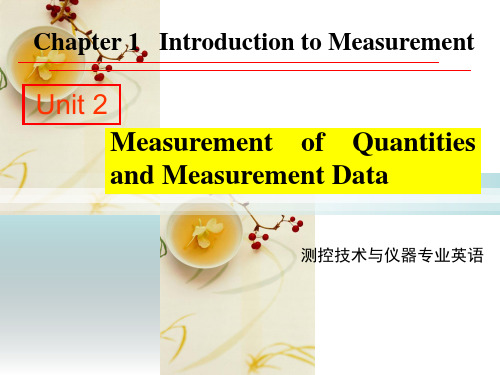
14
2 M- of non-physical quantities
– It is essential to the nature of an organism or an 2.7 organization that they maintain (social, cultural, political) interactions with their environment. – 保持与周围环境的交互对于生命体或组织的性质是非常必 要的。 – For this reason, it is usually not possible to perform an 2.8 isolated measurement in the same way we can with inanimate things (putting in a thermostat, hooking up to a fixed supply voltage, etc. )
7
1 Measurement of Physical Quantity
• Electrical potential difference
– The primary standard for electrical potential difference used to be provided by an electrochemical standard cell (the Weston standard cell).
2 M- of non-physical quantities
– With non-physical measurements, however, the 3.3
测控技术与仪器专业英语
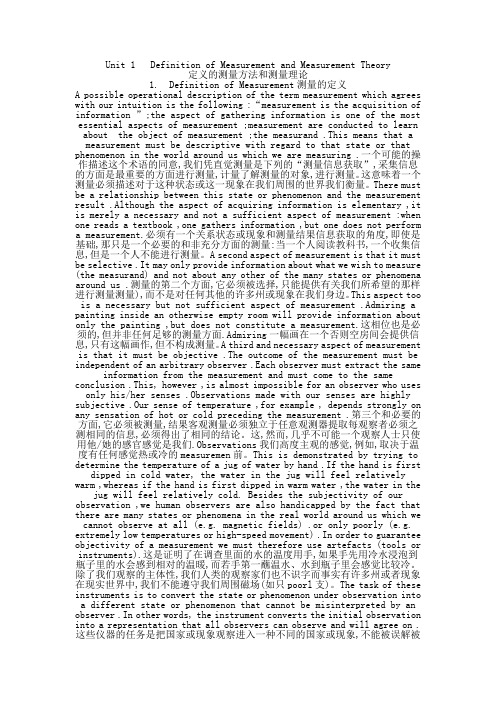
Unit 1 Definition of Measurement and Measurement Theory定义的测量方法和测量理论1. Definition of Measurement测量的定义A possible operational description of the term measurement which agrees with our intuition is the following :“measurement is the acquisition of inform ation ”;the aspect of gathering information is one of the most essential aspects of measurement ;measurement are conducted to learn about the object of measurement ;the measurand .This means that a measurement must be descriptive with regard to that state or that phenomenon in the world around us which we are measuring .一个可能的操作描述这个术语的同意,我们凭直觉测量是下列的“测量信息获取”,采集信息的方面是最重要的方面进行测量,计量了解测量的对象,进行测量。
这意味着一个测量必须描述对于这种状态或这一现象在我们周围的世界我们衡量。
There must be a relationship between this state or phenomenon and the measurement result .Although the aspect of acquiring information is elementary ,it is merely a necessary and not a sufficient aspect of measurement :when one reads a textbook ,one gathers information ,but one does not perform a measurement.必须有一个关系状态或现象和测量结果信息获取的角度,即使是基础,那只是一个必要的和非充分方面的测量:当一个人阅读教科书,一个收集信息,但是一个人不能进行测量。
测控技术与仪器专业英语unit 4
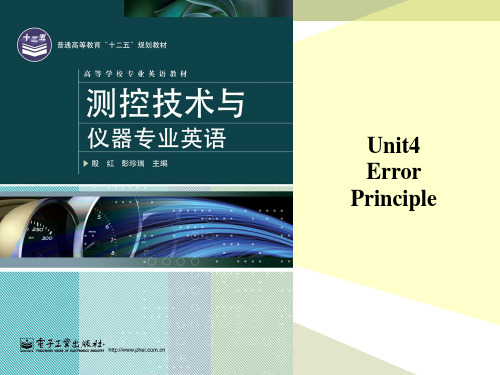
Unit4
Error Principle
Байду номын сангаас
In this case, special consideration must also be given to determining how the calculated error levels in each separate measurement should be combined together to give the best estimate of the most likely error magnitude in the calculated output quantity. 译为:在这种情况下,对于在每个单独的测量中,如 何确定计算的误差等级,以及在计算输出量中给与尽可 能最佳的误差幅度估计,还必须给予特殊的考虑。
7
Unit4
Error Principle
Other sources of systematic error include bent meter needles, the use of uncalibrated instruments, drift in instrument characteristics and poor cabling practices. Even when systematic errors due to the above factors have been reduced or eliminated, some errors remain that are inherent in the manufacture of an instrument. These are quantified by the accuracy figure quoted in the published specifications contained in the instrument data sheet.
《测控技术与仪器专业英语》张凤登-UNIT-1-电气和电子工程引言-参考译文及练习答案

UNIT 1 电气和电子工程引言参考译文1.1 电气工程引言电气和电子工业已逐渐趋于成熟,世界上的每个人,每个家庭及工业都受到它所取得成就的影响。
最明显的是电子计算机在我们生活中各种层次的广泛应用,它的速度、大小和费用使其很容易且很有效地应用于商业和个人事务中。
电子学为几乎每个家庭提供了无线电收音机、电视机、盒式录像机等供娱乐的产品。
集成电路当今已成为现代电子系统的一部分,并不断提供更小、更复杂、更精密的最终产品。
50年代初的工程师会对大量的电路装在一片集成电路上感到惊奇,而今天的工程师可能对发生于2020年的技术进步感到震惊。
由于电子系统为人们提供了很多好处,它无疑已成为越来越多产品的标准元件。
过去由机械元件完成的自动功能正在被相应的电子系统替代。
采用机械拾音传感器的唱机正被电子唱机取代。
机械式打字机正被电子打字机和计算机字处理机代替。
这仅仅是机械系统向电子系统转变的几个例子。
电子工业的发展,部分是由于它的消耗低、尺寸小、被称作超大规模集成电路的相对完整的电子系统,给人以很深影响的是,在一小型计算器中,基本上只有一片很小的集成块,这片芯片只占计算器内部空间的不到五分之一。
在这片超大规模集成电路内部还有一片更小的芯片,所有电路都在该芯片上。
一个超大规模集成电路元件包含成百上千个分离的电子元件,这些元件按不同的功能块排列。
这些功能块包括储存单元,计数电路,记忆电路,运算电路等。
一片单片的超大规模集成电路就是电子表的心脏,它取代了使用很久的模拟运动式手表。
随着电子制作技术的成熟,手表的功能也不断增加。
除了能计时外,附加的复杂电路还具有闹响功能,秒表功能,计算功能,电话号码储存和信息储存更能。
这些仅是较流行的功能。
电子装置已开始使用耗电很低的CMOS电路,从而使象手表中所使用的电路靠一小片电池能连续工作多年。
电子产品在工程中和特殊的商业产品中都得到发展。
体积小、价格低的电子元器件问世时许多新领域中电子系统的应用成为现实,这些领域包括测量仪器、机械、化学、建筑、生物医学工程等。
《测控技术与仪器专业英语》张凤登UNIT-9-操纵装置-参考译文及练习答案
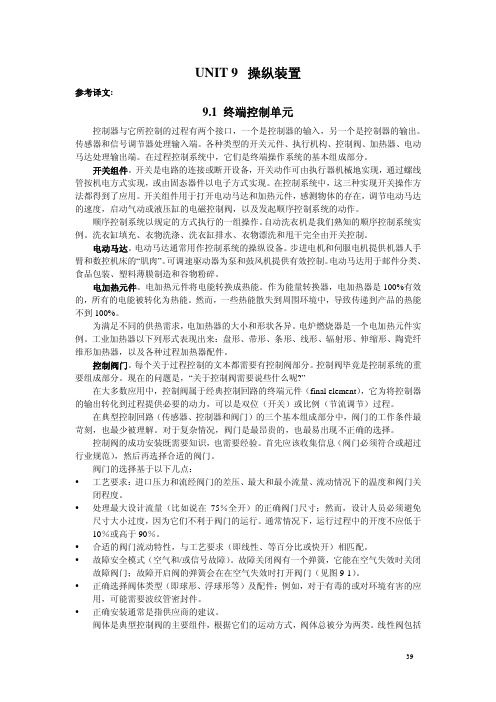
UNIT 9 操纵装置参考译文:9.1 终端控制单元控制器与它所控制的过程有两个接口,一个是控制器的输入,另一个是控制器的输出。
传感器和信号调节器处理输入端。
各种类型的开关元件、执行机构、控制阀、加热器、电动马达处理输出端。
在过程控制系统中,它们是终端操作系统的基本组成部分。
开关组件。
开关是电路的连接或断开设备,开关动作可由执行器机械地实现,通过螺线管按机电方式实现,或由固态器件以电子方式实现。
在控制系统中,这三种实现开关操作方法都得到了应用。
开关组件用于打开电动马达和加热元件,感测物体的存在,调节电动马达的速度,启动气动或液压缸的电磁控制阀,以及发起顺序控制系统的动作。
顺序控制系统以规定的方式执行的一组操作。
自动洗衣机是我们熟知的顺序控制系统实例。
洗衣缸填充、衣物洗涤、洗衣缸排水、衣物漂洗和甩干完全由开关控制。
电动马达。
电动马达通常用作控制系统的操纵设备。
步进电机和伺服电机提供机器人手臂和数控机床的“肌肉”。
可调速驱动器为泵和鼓风机提供有效控制。
电动马达用于邮件分类、食品包装、塑料薄膜制造和谷物粉碎。
电加热元件。
电加热元件将电能转换成热能。
作为能量转换器,电加热器是100%有效的,所有的电能被转化为热能。
然而,一些热能散失到周围环境中,导致传递到产品的热能不到100%。
为满足不同的供热需求,电加热器的大小和形状各异。
电炉燃烧器是一个电加热元件实例。
工业加热器以下列形式表现出来:盘形、带形、条形、线形、辐射形、伸缩形、陶瓷纤维形加热器,以及各种过程加热器配件。
控制阀门。
每个关于过程控制的文本都需要有控制阀部分。
控制阀毕竟是控制系统的重要组成部分。
现在的问题是,“关于控制阀需要说些什么呢?”在大多数应用中,控制阀属于经典控制回路的终端元件(final element),它为将控制器的输出转化到过程提供必要的动力,可以是双位(开关)或比例(节流调节)过程。
在典型控制回路(传感器、控制器和阀门)的三个基本组成部分中,阀门的工作条件最苛刻,也最少被理解。
测控技术与仪器专业英语翻译 殷虹 河北工业大学适用
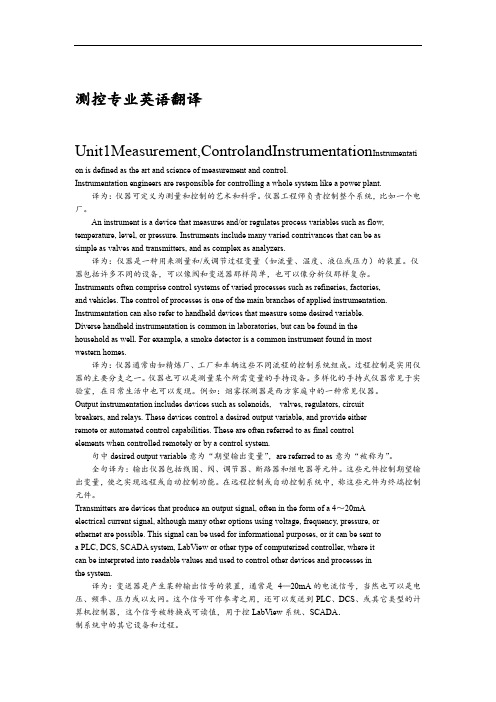
测控专业英语翻译Unit1Measurement,ControlandInstrumentation Instrumentati on is defined as the art and science of measurement and control.Instrumentation engineers are responsible for controlling a whole system like a power plant.译为:仪器可定义为测量和控制的艺术和科学。
仪器工程师负责控制整个系统,比如一个电厂。
An instrument is a device that measures and/or regulates process variables such as flow, temperature, level, or pressure. Instruments include many varied contrivances that can be assimple as valves and transmitters, and as complex as analyzers.译为:仪器是一种用来测量和/或调节过程变量(如流量、温度、液位或压力)的装置。
仪器包括许多不同的设备,可以像阀和变送器那样简单,也可以像分析仪那样复杂。
Instruments often comprise control systems of varied processes such as refineries, factories,and vehicles. The control of processes is one of the main branches of applied instrumentation. Instrumentation can also refer to handheld devices that measure some desired variable.Diverse handheld instrumentation is common in laboratories, but can be found in thehousehold as well. For example, a smoke detector is a common instrument found in mostwestern homes.译为:仪器通常由如精炼厂、工厂和车辆这些不同流程的控制系统组成。
测控技术与仪器专业英语unit

全句译为:然而,供应电压从5V衰减到3.3V甚至更低, 以及系统中多种电压形式的出现,并不只是对最智能的传 感器提出的考验。
Separate integrated circuits (ICs) are available to handle the variety of voltages and resolve the problem, but they add to system and sensor complexity. 译为:单独的集成电路(ICs)可用来处理各种不同的电压 并解决问题,但它们增加了系统和传感器的复杂性。
译为:该转换器将测量的物理量进行转换。观察员对系 统进行修正以使结果接近理想值。典型的测量系统的组成 框图如图3.1所示。
Figure 3.1 General sensing system
6
Unit3 Smart Sensors
Many home thermostats(恒温(调节)器), tire pressure gauges(轮胎气压表), and factory flow meters still operate in the same manner.
Unit3 Smart Sensors
1
Unit3 Smart Sensors
Introduction
Just about everything today in the technology area is a candidate(申请求职者,候选人;报考者)for having the prefix (前缀)smart added to it. The term smart sensor was coined in the mid-1980s, and since then several devices have been called smart sensors.
测控专业英语Unit 4

③The uncertainty of the standard used for calibration.
仪器的准确度取决于三个主要因素:① 距离上次校准的 时间; ②校准和使用时的温差; ③用于标定的标准的不确 定度。
Unit 4
Calibration
2.1 In most organizations,calibration is the responsibility of a separate group. That group is responsible for maintaining working standards, keeping records of instruments for periodic calibration and certification, and being knowledgeable of the latest calibration procedures.
What should the separate calibration groups do according to their tasks and office authorities? 办公权限
Questions before reading
Q4
What are calibration procedures and instrument performance check, and how are they implemented? 校准程序
校准是指为了使仪器与已有标准完全一致 (匹配)而将一个测量仪器与一个标准的或其他 已知准确度的仪器相比较的过程。
Unit 4
Calibration
The established standard is normally of at least four 1.3 times greater accuracy than the instrument being calibrated or the average of multiple standards if the four-times criterion is not feasible. 已有标准通常至少四倍于待校准仪器的准确度,或者 当四倍标准不可行时,则采用多重标准平均方式。 To say that an instrument is calibrated means that it 1.5 indicates measurements within specified limits of error for that instrument. 也就是说,仪器校准表明了其测量误差的确定限度。
测控技术与仪器专业英语翻译-殷虹-河北工业大学适用

测控专业英语翻译Unit1Measurement,ControlandInstrumentationInstrumentation is defined as the art and science of measurement and control. Instrumentation engineers are responsible for controlling a whole system like a power plant. 译为:仪器可定义为测量和控制的艺术和科学。
仪器工程师负责控制整个系统,比如一个电厂。
An instrument is a device that measures and/or regulates process variables such as flow, temperature, level, or pressure. Instruments include many varied contrivances that can be as simple as valves and transmitters, and as complex as analyzers.译为:仪器是一种用来测量和/或调节过程变量(如流量、温度、液位或压力)的装置。
仪器包括许多不同的设备,可以像阀和变送器那样简单,也可以像分析仪那样复杂。
Instruments often comprise control systems of varied processes such as refineries, factories, and vehicles. The control of processes is one of the main branches of applied instrumentation. Instrumentation can also refer to handheld devices that measure some desired variable. Diverse handheld instrumentation is common in laboratories, but can be found in the household as well. For example, a smoke detector is a common instrument found in most western homes.译为:仪器通常由如精炼厂、工厂和车辆这些不同流程的控制系统组成。
测控技术与仪器专业英语UNIT-8-Measuring Technique

analysis of errors and thus determine a “best value” to present the size of
the quantity.
而且,测量的间接性要求必须采用一些非常复杂的数学程序来分析
误差,这样才能确定出一个表征数值大小的“最佳值”。
② gross error
refraction [ri'frækʃən] n. 折光,折射
New Words (continue) trigonometric [,triɡənə'metrik] a. calibration [,kæli'breiʃən] n. unquantifiable [,ʌnkwɔnti'faiəbl] a.
graduated ['ɡrædjueitid] a. 分度的
theodolite [θi'ɔdəlait] n.
经纬仪
bubble dexterity blunder
['bʌbl] n. [dek'sterəti] n. ['blʌndə] n. v.
气泡,泡 灵巧,机敏,灵活,熟练 大错,失误;犯大错,做错
(1) reading (2) instrumental errors (3) inattention (4) be compensated (5) be dealt with
⑷ Mistake actually is not an error because it usually is so gross in magnitude compared to the systematic or random errors.
⑸ Systematic errors follow some physical law and thus can be predicted whereas random errors are introduced into each measurement mainly because of human and instrument imperfections as well as uncertainties in determining the effects of the environment on measurements..
《测控技术与仪器专业英语》张凤登UNIT-0-译文及答案

测控技术与仪器专业英语
参考译文与练习答案
张凤登周美娇尚丽辉编供主讲教师参考
初稿完成日期2015年5月
内容提要
本书是针对张凤登编写的《测控技术与仪器专业英语》教材整理而成的教辅材料,给出了教材的英文文章参考译文和练习答案,内容涉及电气电路、半导体、传感器、测量技术、数字电子系统、计算机、信号处理、智能仪表、控制系统和实时系统等方面,涵盖了测控技术与仪器专业的主要技术基础,并力求反映最新技术进步。
全书共分17个单元,每个单元包括4个部分,分别为Text,Reading and Translation,Further Reading和General Knowledge,有助于读者学习和掌握专业基础知识和专业词汇,阅读和理解专业题材的英语文章,掌握专业英语翻译和写作方面的必备知识。
全书内容丰富,题材新颖,英语和专业知识有机结合,适合不同层次的读者。
本书既可作为高等学校测控技术与仪器专业英语参考资料,也适用于自动化、电子信息、电气工程、计算机类专业,亦可作为工程技术人员的培训资料或参考书。
测控技术与仪器专业英语UNIT-2-Power Generation and Transmission
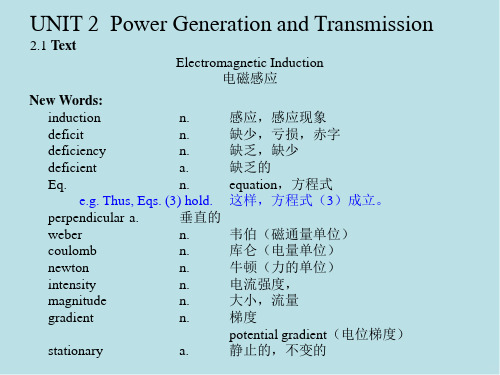
框架尺寸相当时,三相交流电机的功率值比单相交流电机大50%。
2.3 Further Reading
Transformers 变压器
New Words and Phrases
transformer
n.
electromagnetism n.
autotransformer n.
substation
n.
classification
magnetic coupling or mutual inductance 磁耦合或互感
expanding and collapsing of …
…的增强和减弱
powered metal core transformers
强磁化金属芯变压器
step-up
升压的
step-down
降压的
inverse ratio
sine
n.
正弦
transmit
v.
transfer, 输送
pulsate
v.
脉动
cylinder ['silində]
n.
汽缸,气缸,圆柱体
rating ['reitiŋ]
n.
额定值,标称值;级别
测控技术与仪器专业英语课文以及单词
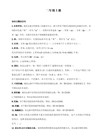
? One can measure thickness on many scales .The galaxy is sphick.. 你可以测量厚度,在许多尺度螺旋星系的约100 Em(1020m磁盘)深
? 3.Distance measurement 3。距离测量
? The tools and techniques of distance measurement are possibly one of humankind's longest-running inventive pursuits .This chapter concerns itself with methods to measure a relatively small segment of this range-from centimeters to kilometers .Even within this limited segment ,it would hardly be possible to list ,much less describe ,all of the distance measurement approaches that have been devised .Nevertheless ,the small sampling of technologies that are covered here should be of help to a broad range of readers.
? The altitude information at air traffic control (ATC) centers is based on pressure altitude measurement that the aircraft transponder system sends after it receives an appropriate interrogation——known as mode C interrogation——transmitted by a secondary surveillance radar. Actually, the altitude information is an atmospheric pressure measurement transformed to altitude indication through a formula expressing the pressure/altitude relationship. When a flight level is cleared for an aircraft, it actually means that the pilot must keep flying on an isobaric surface. However, the altimetry system may present systematic errors (biases) that are different for each airplane, and that significantly affect safety. Thus, the altimetry system performance as well as the aircraft height keeping performance must be monitored by an independent radar or satellite system. 信息的高度,在空中交通管制中心(ATC)根据压高度测量,飞机的应答机系统发给后都把它珍藏一个适当的审讯——被称为模式C讯问——通过二级监视雷达。实际上,高度的大气压力测量信息转化为高度通过公式显示表达压力/高度的关系。当一个飞行高度是允许飞机时,实际上就意味着飞行员必须不停地飞在一个isobaric表面。然而,altimetry系统系统误差可能出现偏差)(飞机的不同而有所区别,明显影响安全。因此,altimetry系统性能以及飞机高度保持性能均须由独立的雷达或卫星电视系统
测控技术与仪器专业英语unit 4

Unit4
Error Principle
Thus, as a general rule, the process of measurement always disturbs the system being measured. The magnitude of the disturbance varies from one measurement system to the next and is affected particularly by the type of instrument used for measurement. Ways of minimizing disturbance of measured systems is an important consideration in instrument design. However, an accurate understanding of the mechanisms of system disturbance is a prerequisite(先决条件,前提)for this. 译为:因此,一般来说,测量过程中总会干扰被测系 统。扰动的大小因测量系统的不同而不同,并且特别容 易受测量仪器类型的影响。如何使测量系统干扰的程度 最小,是仪器设计时需要考虑的一个重要因素。当然, 前提是需要准确地了解系统的干扰机制。 11
Unit4 Error Principle
1
Unit4
Error Principle
2
Unit4
Error Principle
Errors in measurement systems can be divided into those that arise during the measurement process and those that arise due to later corruption of the measurement signal by induced noise during transfer of the signal from the point of measurement to some other point. 句中that从句是those的后臵定语从句,两个those是 并列的宾语成分。
《测控技术与仪器专业英语》张凤登UNIT-x-词汇与参考书-参考译文及练习答案
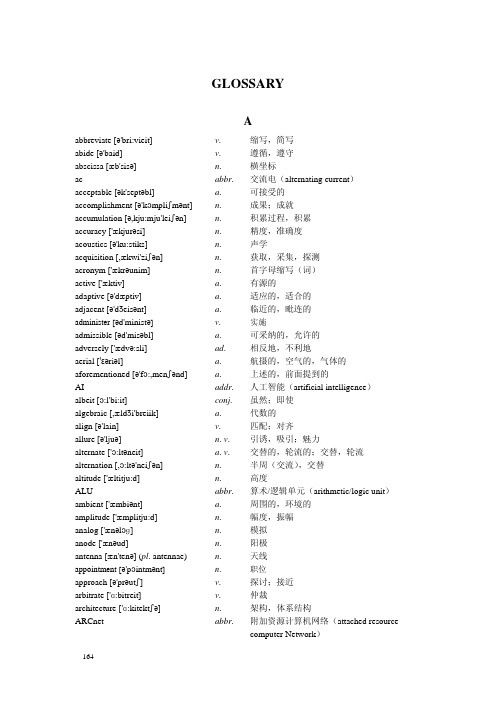
GLOSSARYAabbreviate [ə'bri:vieit] v. 缩写,简写abide [ə'baid] v. 遵循,遵守abscissa [æb'sisə] n. 横坐标ac abbr. 交流电(alternating current)acceptable [ək'septəbl] a. 可接受的accomplishment [ə'kɔmpliʃmənt] n. 成果;成就accumulation [ə,kju:mju'leiʃən] n. 积累过程,积累accuracy ['ækjurəsi] n. 精度,准确度acoustics [ə'ku:stiks] n. 声学acquisition [,ækwi'ziʃən] n. 获取,采集,探测acronym ['ækrəunim] n. 首字母缩写(词)active ['æktiv] a. 有源的adaptive [ə'dæptiv] a. 适应的,适合的adjacent [ə'dʒeisənt] a. 临近的,毗连的administer [əd'ministə] v. 实施admissible [əd'misəbl] a. 可采纳的,允许的adversely ['ædvə:sli] ad. 相反地,不利地aerial ['εəriəl] a. 航摄的,空气的,气体的aforementioned [ə'fɔ:,menʃənd] a. 上述的,前面提到的AI addr. 人工智能(artificial intelligence)albeit [ɔ:l'bi:it] conj. 虽然;即使algebraic [,ældʒi'breiik] a. 代数的align [ə'lain] v. 匹配;对齐allure [ə'ljuə] n. v. 引诱,吸引;魅力alternate ['ɔ:ltəneit] a. v. 交替的,轮流的;交替,轮流alternation [,ɔ:ltə'neiʃən] n. 半周(交流),交替altitude ['æltitju:d] n. 高度ALU abbr. 算术/逻辑单元(arithmetic/logic unit)ambient ['æmbiənt] a. 周围的,环境的amplitude ['æmplitju:d] n. 幅度,振幅analog ['ænəlɔɡ] n. 模拟anode ['ænəud] n. 阳极antenna [æn'tenə] (pl. antennae) n. 天线appointment [ə'pɔintmənt] n. 职位approach [ə'prəutʃ] v. 探讨;接近arbitrate ['ɑ:bitreit] v. 仲裁architecture ['ɑ:kitektʃə] n. 架构,体系结构ARCnet abbr. 附加资源计算机网络(attached resourcecomputer Network)·164·arguably ['ɑ:ɡjuəbli] ad. 有争议地armature ['ɑ:mə,tjuə] n. 电枢,(电机)转子arrangement [ə'reindʒmənt] n. 装置[备],排列,布[配]置ascertain [,æsə'tein] v. 确定assembly [ə'sembli] n. 结构,装配assess [ə'ses] v. 估计,评定assorted [ə'sɔ:tid] a. 已分类的;各式各样的astound [ə'staund] v. 使…大吃一惊astronomy [ə'strɔnəmi] n. 天文学autotransformer [,ɔ:təutræns'fɔ:mə] n. 自耦变压器avionic [,eivi'ɔnik] a. 航空电子学的avoidance [ə'vɔidəns] n. 避免Bbackbreaking ['bæk,breikiŋ] a. 累断腰的,繁重的,非常辛苦的backlash ['bæk,læʃ] n. 齿间隙backplane ['bæk,plein] n. 底板,插接板bandwidth ['bændwidθ] n. 带宽,频带宽度base [beis] n. 基极BCD abbr. BCD码(binary-coded decimal)bellows ['beləuz] n. 波纹管bias ['baiəs] v. 偏置biomedical [baiəu'medikəl] a. 生物医学的bistable [bai'steibl] a. 双稳态的bit [bit] n. 位blind [blaind] a. 盲目的block [blɔk] n. 积木,块blower ['bləuə] n. 鼓风机,吹风机blunder ['blʌndə] n. v. 大错,失误;犯大错,做错boost [bu:st] n. v. 推进,提高,促进,发展bounce [bauns] n. 颤动,跳动brushless ['brʌʃles] a. 无电刷的bubble ['bʌbl] n. 气泡,泡buoyant ['bɔiənt] a. 有浮力的bus [bʌs] n. 总线;母线butterfly ['bʌtəflai] a. n. 蝶形的;蝴蝶bypass ['baipɑ:s] n. 旁路Ccalibrate ['kælibreit] v. 校准calibration [,kæli'breiʃən] n. 标度,刻度,校准CAN abbr. 控制器局域网(controller area network)canonical [kə'nɔnikəl] a. 标准的;规范的·165·capacitance [kə'pæsitəns] n. 电容capacitive [kə'pæsitiv] a. 电容的capacitor [kə'pæsitə] n. 电容器capsule ['kæpsju:l] n. 膜盒carrier ['kæriə] n. 载流子cartridge ['kɑ:tridʒ] n. (唱片)拾音器,卡盘catalyst ['kætəlist] n. 促进因素,催化剂categorize ['kætiɡəraiz] v. 分类cathode ['kæθəud] n. 阴极cavity ['kævəti] n. 腔体cellular ['seljulə] a. 蜂窝状的,网状的,细胞(状)的CEMF abbr. 反向电动势(counter EMF)census ['sensəs] n. 人口统计cereal ['siəriəl] a. n. 谷物的;谷物characteristic [,kærəktə'ristik] a. n. 特性(的),特征,特色;特性曲线charge [tʃɑ:dʒ] n. 电荷chip [tʃip] n. 芯片CIMS abbr. 计算机集成制造系统(computerintegrated manufacturing system)circuit ['sə:kit] n. 电路circuitry ['sə:kitri] n. 电路(总称)clash [klæʃ] v. 抵触,冲突clockwise ['klɔkwaiz] a. 顺时针方向的,counter~, anti~ 逆时针方向的CMOS abbr. 互补金属氧化物半导体(complementarymetal oxide semiconductor)coil [kɔil] n. 线圈coincidence [kəu'insidəns] n. 巧合collector [kə'lektə] n. 集电极collision [kə'liʒən] n. 碰撞,冲突commit [kə'mit] v. 保证commonplace ['kɔmənpleis] a. 平凡的commutator ['kɔmjuteitə] n. 换向器compact [kəm'pækt] a. 紧凑的;密集的compatible [kəm'pætəbl] a. 兼容的,协调的(~ with)component [kəm'pəunənt] n. 元件;部件comprehensive [,kɔmpri'hensiv] a. 综合(性)的compress [kəm'pres] v. 压缩compression [kəm'preʃən] n. 压缩compromise ['kɔmprəmaiz] v. 折衷,损害condition [kən'diʃən] v. n. 调整[节];条件configuration [kən,fiɡju'reiʃən] n. 组态,结构,配置conscientious [,kɔnʃi'enʃəs] a. 尽责的consecutive [kən'sekjutiv] a. 连续的;相继的consistently [kən'sistəntli] ad. 协调地·166·constraint [kən'streint] n. 约束,约束条件contour ['kɔntuə] n. 形状,轮廓contraction [kən'trækʃən] n. 缩写conversely [kən'və:sli] ad. 相反地converter [kən'və:tə] n. 转换器,换流器coordinate [kəu'ɔ:dinit] n. v. 坐标(用复数);调整,整理corrugated ['kɔruɡeitid] a. 波纹的cost-effective a. 性能价格比covalent [kəu'veilənt] a. 共价的coulomb ['ku:lɔm] n. 库仑(电量单位)CPU abbr. 中央处理单元(central processing unit)criterion [krai'tiəriən] n. 判据critical ['kritikəl] a. 关键的crystalline ['kristəlain] n. 晶体的CSMA/CD abbr. 载波监听多路访问/冲突检测(carrier sensemultiple access with collision detection)culmination [,kʌlmi'neiʃən] n. 顶点,极点curvature ['kə:vətʃə] n. 弯曲,曲率custom ['kʌstəm] a. 定制的cutoff ['kʌt,ɔ:f] a. 截止的,未通电的cybernetics [,saibə'netiks] n. 控制论cylinder ['silində] n. 汽缸,气缸,圆柱体Ddam [dæm] n. 坝damp [dæmp] n. v. 阻尼dash [dæʃ] n. 仪表板dc abbr. 直流电(direct current)decade ['dekeid] n. 十decibel ['desibel] n. 分贝deck [dek] n. (录音机)走带机构decoder [,di:'kəudə] n. 解码器decrement ['dekrimənt] v. n. 递减,减少;减量deduce [di'dju:s] v. 推论de-energized [di'enədʒaizd] a. 失电的deficit ['defisit] n. 缺少,亏损deflection [di'flekʃən] n. 偏向,偏转,折射delay [di'lei] n. 延迟,滞后demodulator [di:'mɔdjuleitə] n. 解调器denominator [di'nɔmineitə] n. 分母deposit [di'pɔzit] v. 沉积,沉淀;存放,寄存derivative [di'rivətiv] a. n. 微分,导数;微分的,导数的designation [,deziɡ'neiʃən] n. 标示,名称detached [di'tætʃt] a. 分离的·167·deterministic [di,tə:mi'nistik] a. 确定的detrimental [,detri'mentəl] a. 不利的,有害的deviation [,di:vi'eiʃən] n. 偏差,背离,偏离dexterity [dek'steriti] n. 灵巧,机敏,灵活,熟练diac ['daiək] n. 二端交流开关(元件)diagnose ['daiəɡnəuz] v. 诊断diagonal [dai'æɡənəl] a. 对角的diaphragm ['daiəfræm] n. 膜片dielectric [,daii'lektrik] n. 电介质differential [,difə'renʃəl] a. 差分的,差动的;微分的differentiator [,difə'renʃieitə] n. 微分器digital ['didʒitəl] a. 数字的digitize ['didʒitaiz] v. 将…数字化diode ['daiəud] n. 二极管disc [disk] n. 唱片discern [di'sə:n] v. 看到;辨出dissipation [disi'peiʃən] n. 消散,驱散distinction [dis'tiŋkʃən] n. 区别;差别distortion [dis'tɔ:ʃən] n. 失真disturbance [di'stə:bəns] n. 扰动diverse [dai'və:s] a. 多种多样的DMA abbr. 直接存储器访问(direct memory access)dominant ['dɔminənt] n. a. 显性,显性的dope [dəup] v. 给(半导体等)搀杂DPST abbr. 双刀单掷(double-pole single-throw)drain [drein] n. 漏极droop [dru:p] n. v. 下垂量;下垂DSP abbr. 数字信号处理器(digital signal processor)duct [dʌkt] n. 管道dynamics [dai'næmiks] n. 动态(特性),(动)力学dynamometer [,dainə'mɔmitə] n. 测力计Eecological [,i:kə'lɔdʒikəl] a. 生态的,生态学的effector [i'fektə] n. 操纵装置eigenvalue ['aiɡən,vælju:] n. 特征值elapse [i'læps] v. (时间)过去,消逝electromagnetic [i,lektrəumæɡ'netik] a. 电磁的electromagnetism [i,lektrəu'mæɡnitizəm]n. 电磁学electromechanical [i,lektrəumi'kænikəl]a. 机电的,电机的electromotive [i,lektrəu'məutiv] a. 电动的element ['elimənt] n. 元件eliminate [i'limineit] v. 排除,消除embark [em'bɑ:k] v. 从事,着手·168·embed [im'bed] v. 嵌入embrace [im'breis] v. 包括EMF abbr. 电动势(electromotive force)emitter [i'mitə] n. 发射极emulation [,emju'leiʃən] n. 竞争,仿真enamel [i'næməl] n. 珐琅encapsulate [in'kæpsəleit] v. 封装energize ['enədʒaiz] v. 给…通电energized ['enədʒaizd] a. 通电的entity ['entəti] n. 实体equilibrium [,i:kwi'libriəm] n. 平衡,均衡equivalent [i'kwivələnt] n. 相等的;相同的Eq. (equation [i'kweiʒən]) n. 方程(式),等式erasable [i'reizəbl] a. 可擦除的ESP abbr. 电子稳定程序(electronic stability program)etch [etʃ] v. 刻蚀,刻画evaluate [i'væljueit] v. 评价evaluation [i,vælju'eiʃən] n. 估计event [i'vent] n. 事件evolve [i'vɔlv] v. 发展,演变,进化exclusively [ik'sklu:sivli] ad. 排外地,专有地excursion [ik'skə:ʃən] n. 偏差executable ['eksikju:təbl] n. a. 可执行文件,可执行的exert [iɡ'zə:t] v. 施加。
测控技术与仪器专业英语

全句译为:然而,微处理器技术的出现使得传感器必须要 有电信号输出,这样便于接口以实现无人测控。
8
Unit3 Smart Sensors
That also required the analog signal level to be amplified and converted to digital format prior to (在……之前) being supplied to the process controller. Today’s MCUs and analog-to-digital (A/D) converters typically have a 5V power supply, which has dictated the supply voltage for many amplified and signal conditioned sensors.
译为:一些半导体制造商正在积极的进行控制系统的输 入和输出两个方面的智能装置的研究。微机电系统 (MEMS)这个术语用来描述对传感器和加载器用半导体 制造工艺建立的结构。
5
Unit3 Smart Sensors
Before the availability of microelectronics, the sensors or transducers used to measure physical quantities, such as temperature, pressure, and flow, usually were coupled(连接,联结,联系)directly to a readout device, typically a meter that was read by an observer.
《测控技术与仪器专业英语》张凤登UNIT-12-真实世界的信号处理-参考译文及练习答案

UNIT 12 真实世界的信号处理参考译文:12.1 A/D 和D/A 转换基于数字计算机的工业控制器的共同特点之一,是能够使用A/D 和D/A 转换器实现与模拟设备的连接,这些转换器有时设计在控制器内。
在计算机的输入端,测量过程提供模拟形式的电信号。
这种信号被数字化为二进制串,然后输入到控制器的数字处理器和存储器。
在输出端,驱动执行器的信号由二进制数字输出进行控制,这些数字输出通过D/A 转换器转换为模拟信号。
电位传感器的电气输出是很多传感器的典型输出:它是一个连续信号或模拟信号。
在可由计算机读取它之前,必须将其数字化。
模拟到数字(A/D )转换器是将连续的模拟信号转换成数字形式的器件。
这种转换的步骤如下:⑴ 周期性地采样连续信号,形成一系列的离散时间采样。
⑵ 每个离散模拟采样属于有限数量的预定义幅度水平之一,预定义幅度水平即所谓的量化水平,它由在A/D 器件的有效范围之上的离散电压组成。
⑶ 幅度水平编码成数字形式,以供控制器的数字处理器采集。
例如,一个8位的二进制输出意味着这个A/D 转换器能够将模拟电压分成256个离散电平。
这样的数字化读数是控制器内处理器存储器的输入。
接下来,我们将详细讨论模拟和数字系统之间转换信号的过程。
D/A 转换器这里,我们研究一个4位(4-bit )二进制数转换为电压电平的基本过程。
计算机提供的4位二进制数,呈现给D/A 转换器的可能输入状态为24=16个。
输出电压所要求的范围必须设计到D/A 器件。
器件的完整电压范围是0~11.25V 。
输入的二进制数范围可为0~15。
由于在整个11.25V 范围内有15个增量,二进制数的每个增量等于11.25/15 = 0.75V 。
二进制数增加1会使D/A 转换器的输出电压增加0.75V 。
输出(电压或电流)可以通过二进制输入进行控制的,术语步长(step size )用来表示输出的最小增量。
在本例中,步长为0.75V 。
步长与分辨率百分比(percent resolution )有关,其大小等于每步的电压(或电流)占完整电压(或电流)范围的百分比。
测控技术与仪器专业英语unit

Much like digital differential input signals such as LVDS, the analog signals may be inverted to a double dynamic range as is commoices.
译为:基本元件的输出是对它测量的变量的度量。但 是它很少采用一种便于传输或被系统中其他部分使用的形 式。
Usually, a signal conditioner is required to convert the primary element output into an electrical (or pneumatic) signal suitable for use by a controller or display device. A signal conditioner prepares a signal for use by another component. The input to a signal conditioner is usually the output from a sensor (or primary element).
句中balanced input意为“对称输入”,CommonMode Rejection Ratio (CMRR)意为“共模抑制比”。
译为:差动装置在接收两输入端口的差分信号时,抑制 这两个对称输入端口(+和-)的共模输入信号,这称为 共模抑制比CMRR。这个装置被这样设计两个输入共有 的噪声被抑制而所需要的信号不被抑制。
句中differential有“微分”和“差分”之意,这里指 信号处理的方式,意为“差动”。
译为:电压输出传感器的信号处理有3种输入拓扑方式: 差动方式、单端方式和伪差分方式。信号调制输入的类型 要符合特定的输出结构和传感器的准确性要求。
- 1、下载文档前请自行甄别文档内容的完整性,平台不提供额外的编辑、内容补充、找答案等附加服务。
- 2、"仅部分预览"的文档,不可在线预览部分如存在完整性等问题,可反馈申请退款(可完整预览的文档不适用该条件!)。
- 3、如文档侵犯您的权益,请联系客服反馈,我们会尽快为您处理(人工客服工作时间:9:00-18:30)。
全句译为:然而,微处理器技术的出现使得传感器必须要 有电信号输出,这样便于接口以实现无人测控。
8
Unit3 Smart Sensors
That also required the analog signal level to be amplified and converted to digital format prior to (在……之前) being supplied to the process controller. Today’s MCUs and analog-to-digital (A/D) converters typically have a 5V power supply, which has dictated the supply voltage for many amplified and signal conditioned sensors.
译为:应用微电子技术之前,传感器或转换器用于测量 物理量,如温度,压力,流量,通常直接与读数装置相连, 通常一个仪表有一个观察员读数。
6
Unit3 Smart Sensors
The transducer converted the physical quantity being measured to a displacement. The observer initiated system corrections to change the reading closer to a desired value. The typical blocks of a measurement system are shown in Figure 3.1.
译为:在今天几乎一切的技术领域都将智能一词作为 其前缀的候选。智能传感器这一术语是在20世纪80年代 中期出现的,从那以后,一些设备已被称之为智能传感器。
3
Unit3 Smart Sensors
The intelligence required by such devices is available from microcontroller unit (MCU), digital signal processor (DSP), and application-specific integrated circuit (ASIC) technologies developed by several semiconductor manufacturers.
句中microcontroller unit(MCU)意为“微控制器单元”, digital signal processor (DSP)意为“数字信号处理器”, application-specific integrated circuit (ASIC)意为“特殊 应用集成电路”。
全句译为:这些设备所具有的智能源于半导体生产厂家开 发的微控制器(MCU)、数字信号处理器(DSP)和特 殊应用集成电路(ASIC)技术。
译为:一些半导体制造商正在积极的进行控制系统的输 入和输出两个方面的智能装置的研究。微机电系统 (MEMS)这个术语用来描述对传感器和加载器用半导体 制造工艺建立的结构。
5
Unit3 Smart Sensors
Before the availability of microelectronics, the sensors or transducers used to measure physical quantities, such as temperature, pressure, and flow, usually were coupled(连接,联结,联系)directly to a readout device, typically a meter that was read by an observer.
译为:传感器和转换器中常用的定义,必须首先对一 些术语进行定义。转换器是这样一种装置,它将能量从 一个范围转换到另一个范围,并进行校准以减少在转换 过程中的误差。而传感器是给特定的被测设备提供了一 个有用的输出。
11
Unit3 Smart Sensors
The sensor is a basic element of a transducer, but it also may refer to a detection of voltage or current in the electrical regime(物理条件,环境,组织方法;管理体制, 政体)that does not require conversion. Sometimes, the terms are used synonymously(同义地), because energy conversion is part of every device that is discussed.
译为:该转换器将测量的物理量进行转换。观察员对系 统进行修正以使结果接近理想值。典型的测量系统的组成 框图如图3.1所示。
Figure 3.1 General sensing system
7
Unit3 Smart Sensors
Many home thermostats(恒温(调节)器), tire pressure gauges(轮胎气压表), and factory flow meters still operate in the same manner.
测控技术与仪器专业英语unit
Unit3 Smart Sensors
2
Unit3 Smart Sensors
Introduction
Just about everything today in the technology area is a candidate(申请求职者,候选人;报考者)for having the prefix (前缀)smart added to it. The term smart sensor was coined in the mid-1980s, and since then several devices have been called smart sensors.
译为:许多家用自动调温器,轮胎压力表和工厂流量计 也以同样的方式运作。
However, the advent of microprocessor technology initiated the requirement for sensors to have an electrical output that could be more revide unattended measurement and control.
主语为the reduction和the presence,谓语为pose,宾语 challenges。
全句译为:然而,供应电压从5V衰减到3.3V甚至更低, 以及系统中多种电压形式的出现,并不只是对最智能的传 感器提出的考验。
Separate integrated circuits (ICs) are available to handle the variety of voltages and resolve the problem, but they add to system and sensor complexity. 译为:单独的集成电路(ICs)可用来处理各种不同的电压 并解决问题,但它们增加了系统和传感器的复杂性。
译为:传感器是转换器的基本元素之一,但是在不需要 进行转换的电气方面,传感器可能会用于电压或电流的检 测。有时候,传感器和换能器会被等价的应用,因为能量 转换是每个被讨论的设备的一部分。
12
Unit3 Smart Sensors
The definition of smart sensor (intelligent transducer) has not been as widely accepted and is subject to misuse. However, an Institute of Electrical and Electronics Engineers (IEEE) (电气和电子工程师协会)committee has been actively consolidating terminology(专门用语,术 语,术语学,术语的正确使用,术语用法)that applies to microelectronic sensors. 译为:智能传感器(智能转换器)的定义并没有被广泛接 受,并且遭受了滥用。 然而,电气电子工程师协会 (IEEE)委员会已经积极地加强推广此术语应用于微电子 传感器。
13
Unit3 Smart Sensors
The recently approved IEEE 1451.2 specification defines a smart sensor as a sensor that provides functions beyond those necessary for generating a correct representation of a sensed or controlled quantity. This function typically simplifies the integration of the transducer into applications in a networked environment.
4
Unit3 Smart Sensors
Some of those same semiconductor manufacturers are actively working on smarter silicon devices for the input and output sides of the control system as well. The term microelectromechanical system (MEMS)(微机电系统) is used to describe a structure created with semiconductor manufacturing processes for sensors and actuators.
